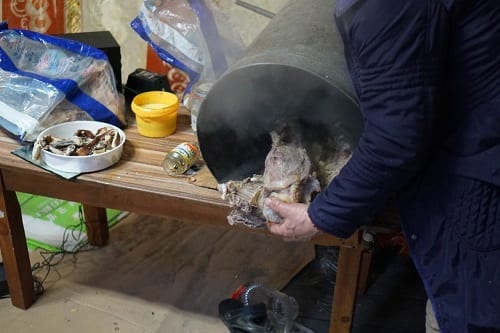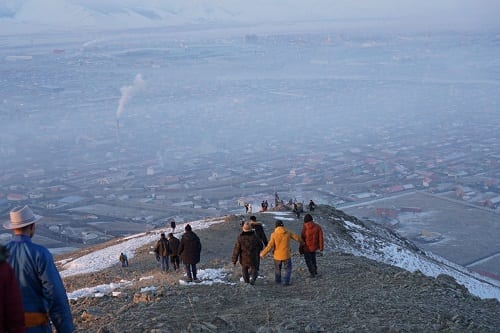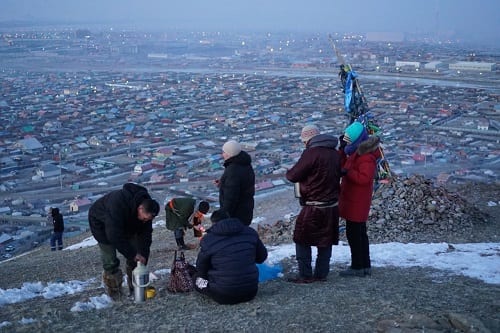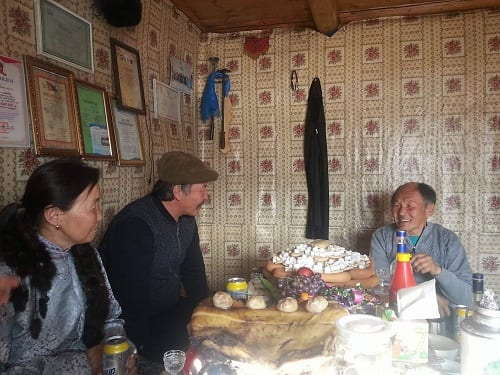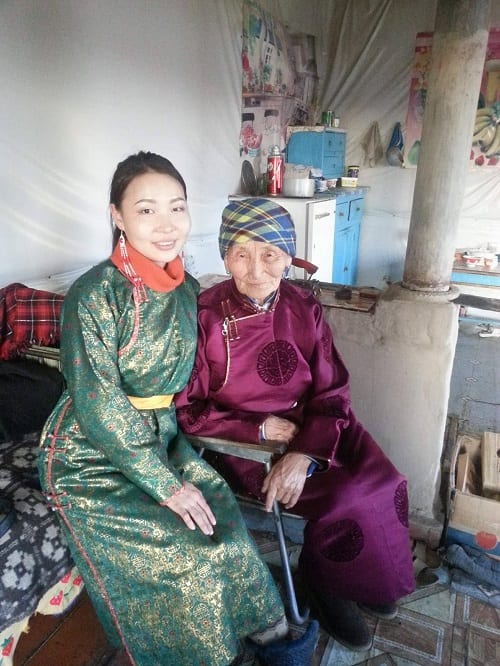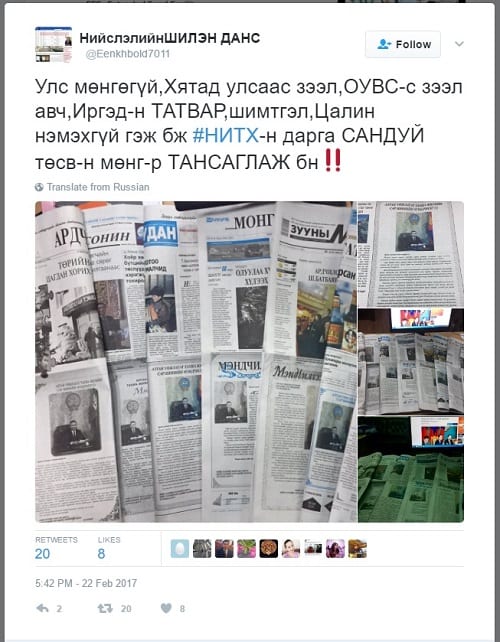The Tsagaan Sar Gift Index – 2017
By ucsaar0, on 31 March 2017
This post was compiled by Rebecca Empson, with contributions from members of the Emerging Subjects research group, and special reports from Liz Fox in Mongolia, and Bumochir Dulam in England.
This is the third year of our Tsagaan Sar gift index (!). Our friends and interlocutors reported that this year the preparation of gifts and food did not take up too many days (or weeks beforehand), and, like previous years, many gifts were simple, Mongolia-made products like socks and scarfs. There was an emphasis on visits to families (and also documenting these visits on social media) within the first 2-3 days.
Because the economic crisis continues, people reported that they were only giving presents that were an exact fit for the person (yag zoriulj avsan yum shig). In both the countryside and the city it was recounted, people only gifted items that were necessary, everyday items (heregtseetei yum), with less people gifting luxury things. Also, it was usual to only gift one item, or to gift money instead. Some people reported that while last year people greeted with 20,000 tg bills, this year – in both the countryside and the city – it was common to greet with 5-10,000 tg notes. People reported that ‘good quality’ products were the most important and many said that they focused more on preparing food (making buuz).
So, in general, we see a trend of less days celebrated and less days spent preparing, an intense recycling of gifts, and a focus again on Mongolia-made products where possible, with a smaller amount of money gifted than last year.
***
Celebrating Tsagaan Sar in Mongolia
In the following, Liz Fox (ERSC-funded PhD student at UCL Anthropology) presents a detailed report from her fieldsite located in the Eastern ger district of Ulaanbaatar, of the shopping trip before the first day of the New Year, and the exchange and recycling of gifts that took place during Tsagaan Sar.
– A shopping trip for the New Year
This year Tsagaan Sar was celebrated in my fieldsite with a piece of cow meat instead of a sheep’s back. The meat was bought from the family’s son-in-law for 100,000MNT (Mongolian Tögrög, tg).[1] Just over 1,000 buuz (steamed dumplings) were prepared with goat meat and were made two nights before the first day of Tsagaan Sar (shiniin negen). We made some additional buuz on the night of bituun (the night before the first day of the New Year). One buuz had a 5,000MNT note hidden inside and was deemed the ‘lucky buuz’: whoever found it was deemed to have ‘met/coincided with’ (taarah) luck (az) and would be lucky for that year. A lucky buuz was made in a relative’s family but this buuz was hidden in the general Tsagaan Sar dumplings and was found by their son on the third day of Tsagaan Sar. Apart from the meat and dried shortbread (heviin boov), all the shopping for Tsagaan Sar was done on the day before the first day of the New Year (bituun). This was because the mother of the household was working up until that day and had no time to go to the market.
Going to the market on bituun was less busy than had been expected, but perhaps that was due to arriving at 10am – when Narantuul Zah opens. That morning, I was asked to write a list of everything the family needed to buy (see below). The expenses of this year were reduced (as they were the previous year). I brought with me from the UK a large supply of gifts, particularly gifts for women (make-up, hair and beauty products) and children (notebooks, stickers, headphones). I also brought some gifts suitable for men (knives, cutlery sets), a large amount of general gifts (chocolates, sweets, candies) and three bottles of alcohol (two whiskies and one sloe gin). This meant that most of the shopping on bituun was for specific gifts for members of the immediate family and a few items to beautify the home.
Saraa, a 47 year old mother of 5 who lives in an Ulaanbaatar ger district led our shopping trip to the market and was accompanied by her husband, two daughters (23yrs and 6yrs) and myself. At the market, we began at an indoor food-selling area and bought dried curds (aaruul) (around 15,000MNT) and some raisins (choosing 500g of the cheaper Chinese raisins at 7,000MNT/kg over the more-expensive Russian ones at 10,000MNT/kg). A large glass jar of pickled cucumbers (7,000MNT), a jar of tomato-based vegetable salad (salat) (3,500 MNT) and a plastic tub of mayonnaise (5,000MNT) was also bought. Saraa used the salary she had been paid in the previous days, which amounted to 70,000MNT. However, a mistake had been made at her work place – the hours of overtime that she and her colleague worked were confused by the boss and each woman’s pay was deposited into the other’s account. Fortunately, the colleague alerted Saraa to the mistake and the two met in the market where the colleague handed over 160,000MNT. 100,000MNT of this money was immediately given to one of the many people roaming the market selling ‘new bills’ appropriate for greeting (zolgoh) and gifting. The 100,000MNT was returned for a large stack of new 500MNT bills with 10,000 (10%) added for the exchanger.
From there we roamed the open and semi-covered market picking up the items on the shopping list. The household items consisted of new plastic covers for the two tables, 3 meters of a gold and silver flower-covered design bought for 7,000/m (28,000MNT) and two new posters for the walls, a large one of a beautiful mansion (the shopkeeper said “This is a rich person’s house, may you live in one one day”) and a smaller one of a basket of exotic fruit (2,000, 1,500 MNT). A doormat for the entrance (4,000MNT) and two sets of 10 bowls were also bought: a set of larger, yellow, flower-decorated bowls for 2,000MNT/bowl and smaller simple white bowls for 700/bowl (27,000MNT). After that, specific presents for members of the immediate family were bought according to their needs. Underwear was bought for the teenage sons, 2 pairs for 2,000MNT/boxers and another for the 23-year-old daughter (1,000MNT), a pair of spring boots for the 7-year-old daughter (15,000MNT), three pairs of black elasticated trousers (7,000MNT), two for the 23-year-old daughter and one for the mother. The father of my family was supposed to have a coat, boots and underwear bought for him, but he resisted and nothing was bought. He was already carrying a heavy bag bought at the market (1,000MNT) containing all the purchased items and was perhaps resistant to the idea of ending up with more to carry. A toy car (7,000 MNT) was bought for the family’s grandson and a pair of jeans for the son-in-law (18,000 MNT). The largest purchase by far was a brass pinkie-finger ring that Saraa insisted on buying for me despite my protests. This cost 85,000 MNT perhaps showing that having a foreign ‘daughter’ who brings unexpected presents (thereby saving the family a great deal of money) can also produce otherwise unnecessary expenses. The elder daughter and I were also bought a pair of Mongolian-made socks (the present I had initially requested) for 2,500MNT each. Two large thermoses were bought as presents for maternal and paternal grandmothers. A new chimney for Saraa’s home stove was also bought just before leaving the market. It was decided that the 10 additional ‘men’s’ presents weren’t necessary – money would be given instead.
The eldest teenage son had requested trousers from a more expensive shop (and had stayed home with his brother in a grump at Saraa’s refusal to buy such an expensive item for him). While at the market, Saraa relented and changed her mind. As we walked from the market to the nearby Nomin supermarket we passed a man selling pinenut filled pillows out of the back of a car and bought 3 for 2,000MNT each. We arrived at Nomin (also the work place of the eldest daughter). We ate lunch at the Nomin food court, sharing two dishes (total 20,000 MNT) and bought the expensive trousers for the two sons (24,900MNT and 32,000MNT). It was when we were leaving that we suddenly realised that while buying the pillows, someone had set down the table covers and the posters that had all been rolled up together and forgotten them. The elder daughter was sent back to check if they were still there while the rest of us took the bus to the smaller market nearer the home.
There Saraa bought some apples, mandarins and nuts. The daughter caught up with us, saying that there was no sign of the lost items, so Saraa was forced to buy 2 more meters of table cover, both less beautiful and more expensive than the lost one (10,000MNT/m). The market had sold out of cucumbers and sausage (hyam) so we left and took a taxi home. There was no more money to buy extra basic provisions such as flour, rice and sugar but Saraa said we would get by with what was at home.
In total, I calculate that the above came to approximately 471,400MNT. However, some items were missing, or were purchased before my arrival, and some prices have had to be estimated, so it is only a very rough guide.
– The Flows and Stoppages of New Year Gifting
While Tsagaan Sar is celebrated simultaneously by the whole Mongolian society, there are fairly distinct layers and differences in how people celebrate. At my fieldsite, exchanging greetings with 500 MNT notes was common and only a few of the most elderly people were greeted with notes of 1000MNT or more. Gifts, here, were also of low monetary value, averaging only a few thousand MNT. Popular gifts included tights for women and socks for men. Among ger district-dwelling families there are also differences. I heard of families in Western ger districts greeting with a minimum of 5000MNT notes (rising to 10,000 or 20,000 MNT for more senior family members). In such areas, gifts were also more expensive such as 6,000MNT belts for men and 5,000-10,000MNT cosmetic sets for women. My apartment-dwelling friends from higher socioeconomic backgrounds also used 5,000MNT to 20,000MNT notes for greeting and exchanged gifts, with an average price of over 10,000MNT rising to expensive alcohols that can cost over 100,000MNT. Different groups also shop at different markets for gifts. Purchasing gifts at ‘Expos’ is a sign of wealth and distinction – evidencing the giver’s capacity to give a product manufactured somewhere other than China. Lower income families are restricted to purchasing from the city’s markets such as Khar Khorin in the West and Narantuul in the East. The poorest families may even be reduced to giving whatever they have at hand, including in some cases a ‘used’ product such as an opened container of body moisturiser. Giving away household items can also happen when a family’s supply of gifts runs low (e.g. raiding the cupboard for a bowl to give, or a bookshelf for a book) or even to give a particularly special present (for example, I was gifted a silver bowl at a wealthy friend’s home when I paid an unanticipated visit).
Some gifting practices are universal across income divides. Primary among these is the ‘recycling’ of gifts. Most gifts received are, in fact, not kept by the recipient but upon returning from a visit are deposited into the ‘gift box’ to be given on again to those who will visit. Even the money collected from greetings is generally given on in a subsequent greeting. This practice is expected, but may also be counteracted in specific cases, such as when Saraa gave a cutlery set to her younger brother and insisted that he not give it away as it came from abroad and was of high quality. In the giving of the make-up I had brought, Saraa also made a point of letting relatives select colours that suited them and similarly telling them that this was high quality make-up that she expected them to keep and use!
In general, people do keep a small number of gifts they receive – selecting a special gift or two that they particularly like or need. However, there is a common sentiment that after all the expense, work and exchange-making of Tsagaan Sar, people generally end up with almost nothing except an overly-full belly and a few moments of varying drunkenness. This is quite remarkable for a celebration that costs even a low-income family at least 1 million MNT and a richer family anything from 3 million MNT up. On our drive to the airport on the fourth day of the new year, Saraa expressed this explicitly, saying with a wry laugh, “At Tsagaan Sar, we spend so much and work so hard and yet we end up with nothing! No meat, no presents, no money! Where is does it all go? Baihgvi (‘Nothing Left’)!”
I pondered this myself and could only come up with a partial and speculative response about where all the money and gifts end up. My answer relies on the fact that although it is often presented as mutual, visiting one another is not actually a fully reciprocal activity. Firstly, the established custom is that youngers must visit elders, while elders do not necessarily visit youngers, indeed it is common for them to wait for an invitation that may or may not come, and may or may not be acted upon. As gifts are given by the hosts, and greetings by youngers to elders are more likely to involve money, there may be a degree to which gifts move down the age hierarchy while money moves up. Those in the middle generations thus serve as only temporary stopping points in these exchange networks. The terminal points may therefore consist of two distinct groups: the first is the very elderly. The second is the poorest and youngest families. The very elderly receive many visitors, but may not be physically capable of visiting their youngers, thus they collect money but not presents. The poorest, youngest families, on the other hand, may make many visits and collect presents but are not obliged to invite their elders for reciprocal visits that they cannot afford to properly host. Thus, they do not end up giving away the presents they receive. Such families save money not only by not preparing their own table and presents, but also by greeting their elders with only a silk scarf – an entirely acceptable and respectful form of greeting. The middle generations and middle-income families are the ones that probably feel the economic squeeze of the New Year most acutely.

Preparing the ‘dogs food’ on bituun. It is really important that they are fully fed, just like people. © Liz Fox 2017.
***
In the following Bumochir Dulam (UCL Anthropology) reflects on his experience preparing for and celebrating Tsagaan Sar in London in the U.K.
Celebrating Tsagaan Sar in London 2017
Celebrating Tsagaan Sar in London can be challenging and costly. Unofficial sources say there are approximately 2,500 Mongols in London, including students and migrant workers. Many of those living in London are relatively young, and away from their homes and families. Not many are in regular contact with each other and are unable to form an active community.
– Groups to celebrate with
Celebrating Tsagaan Sar usually takes place within the family, and with relatives and friends, with a particular tradition to show respect to the elderly. Because many Mongolians living in London are here on their own, it keeps the range of people one can visit to a relatively small group. Families with elderly members of 50 years and above who have been permanently living in London for the last several years tend to celebrate Tsagaan Sar on a larger scale than others and host a larger number of guests, up to 20 to 30 or more. Also, those whose parents are visiting London tend to celebrate Tsagaan Sar. Others tend to celebrate within the immediate family circle with their children and close family friends.
– Sourcing Foods and Gifts
Those who celebrate Tsagaan Sar often have certain major expenses to buy sheep back (uuts), mutton (or lamb) to boil and to make steamed dumplings (buuz), hard shortbread (heviin boov), vodka, gifts and traditional costumes (deel) and boots etc. Most Mongolians living in London go to Smithfield wholesale butcher market located in the City of London near Barbican station. The market opens from 2am to 8 am. Although it is open during the night, it is one of the few places where one can see many Mongolians, especially in the week before Tsagaan Sar. When I went to Smithfield, I met several Mongolians, mostly men. Many of them bought at least one or two whole lamb or mutton. The cost of lamb or mutton was in average 4 to 6 GBP. The average weight of a whole lamb or mutton is about 20 kg and the total cost of one whole lamb was about 80 to 120 GBP. Unlike Mongolian sheep, sheep breeds in the UK are not fat-tailed. The fatness of the sheep tail and size matters very much. A UK sheep tail is always considered highly lacking and most inappropriate for Mongolian Tsagaan Sar. Sourcing hard shortbread (heviin boov) is another major problem for Mongolians living in London. Some people make it at home in their oven, while it is actually supposed to be deep-fried. Some Mongolians actually make shortbread in London and sell them online in the Facebook group called “Mongol Ads in the UK” (UK giin Mongol zar). In the group one can find not only shortbread, but many other Mongolian-made products which cannot be found in London. These include dairy products, such as dried curd (aaruul) and cheese, Mongolian vodka, frozen dumplings, etc. Ads from previous years show that in 2014 the price of one shortbread was 4 GBP, in 2015, 10 shortbreads was sold for 35 GBP. Families need at least 9 shortbreads to pile them up in the form of a ceremonial offering. Under the Facebook group advertisement some comments from France asked whether they can buy them and get them sent by post to Paris; some others also decided to bring shortbreads from Mongolia. This year a friend of mine, Baagii, who lives in London decided to buy ten shortbreads from Mongolia and get them shipped from Ulaanbaatar to London by plane using a shipping company called “Mongol Centre”. Shipping by aeroplane cost around 8 GBP per kilo, and he had to pay about 60 GBP.
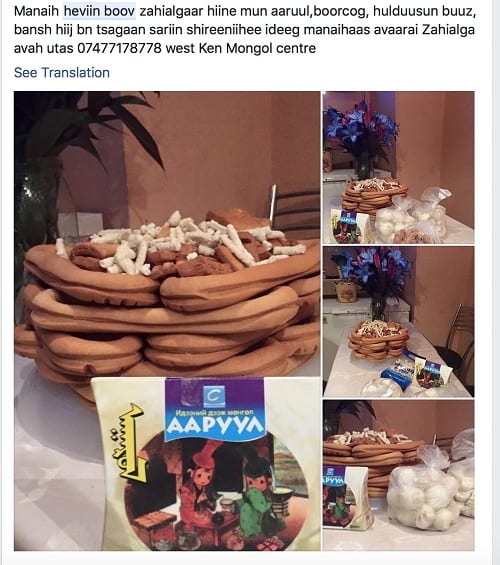
Post on Facebook advertising shortbread, dried curd, and frozen dumplings. https://www.facebook.com/groups/ukmongolchuud/
An important beverage in the celebration of Tsagaan Sar is Mongolian Vodka. In London, it is luxurious to source Mongolian vodka during Tsagaan Sar, while many other vodka brands are available in any liquor store in London. Unlike shortbread, Mongolian vodka is always available in the above-mentioned Facebook group. A bottle of 0.75L Mongolian vodka is, on average, 30 to 45 GBP.
It is a trend to wear Mongolian traditional clothes during Tsagaan Sar and Naadam. Although it is common for most Mongolians to bring traditional garments (deel) and boots from Mongolia to wear on certain celebratory occasions, when Tsagaan Sar approaches one can find many public posts on Facebook asking for a deel. It is growing in popularity to look for a pair of deels for a couple. The price range for a deel varies widely from 50 to 200 GBP, according to the material, design and craft. Many Mongolian women can also make deel, as it is a tradition for Mongolian women to learn how to sew a deel. When I visited one of my Mongolian friends in London, I met a Mongolian couple who were also there with their baby daughter. The couple and the toddler were wearing a Mongolian designer deel made with the same fabric. Apparently, it was the wife who made those.
Gift are the next important part of Tsagaan Sar. Mongolians in London also use new bills of 5, 10 and 20 GBP as a gift when they greet (zolgoh) elderly people. If the celebration is in a smaller circle of family and friends, then gifts are usually intentionally prepared for each person (zoriulj avsan). In the case of my family we specifically brought from Mongolia some souvenirs, Mongolian-made chocolates and dried curds to give as gifts to friends. For example, we gave a small cast-metal golden horse headed fiddle (morin huur) and a collection of china with images depicting Mongolian national games.
***
Celebrating Tsagaan Sar in the countryside
Below are some photos that friends in Khentii province in northeastern Mongolia shared reflecting their Tsagaan Sar experiences:
[1] The USD – MNT exchange rate in late February was around 2,467MNT = $1.
 Close
Close


